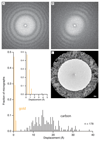Specimen Preparation for High-Resolution Cryo-EM
- PMID: 27572723
- PMCID: PMC5140023
- DOI: 10.1016/bs.mie.2016.04.011
Specimen Preparation for High-Resolution Cryo-EM
Abstract
Imaging a material with electrons at near-atomic resolution requires a thin specimen that is stable in the vacuum of the transmission electron microscope. For biological samples, this comprises a thin layer of frozen aqueous solution containing the biomolecular complex of interest. The process of preparing a high-quality specimen is often the limiting step in the determination of structures by single-particle electron cryomicroscopy (cryo-EM). Here, we describe a systematic approach for going from a purified biomolecular complex in aqueous solution to high-resolution electron micrographs that are suitable for 3D structure determination. This includes a series of protocols for the preparation of vitrified specimens on various supports, including all-gold and graphene. We also describe techniques for troubleshooting when a preparation fails to yield suitable specimens, and common mistakes to avoid during each part of the process. Finally, we include recommendations for obtaining the highest quality micrographs from prepared specimens with current microscope, detector, and support technology.
Keywords: Cryo-EM; Electron cryo-microscopy; Electron tomography; Protein structure; Single-particle reconstruction; Substrates.
© 2016 Elsevier Inc. All rights reserved.
Figures











References
-
- Adrian M, Dubochet J, Lepault J, McDowall AW. Cryo-electron microscopy of viruses. Nature. 1984;308(5954):32–36. - PubMed
-
- Bernecky C, Herzog F, Baumeister W, Plitzko JM, Cramer P. Structure of transcribing mammalian RNA polymerase II. Nature. 2016;529(7587):551–554. - PubMed
-
- Brenner S, Horne R. A negative staining method for high resolution electron microscopy of viruses. Biochimica et Biophysica Acta. 1959;34:103–110. - PubMed
Publication types
MeSH terms
Substances
Grants and funding
LinkOut - more resources
Full Text Sources
Other Literature Sources

